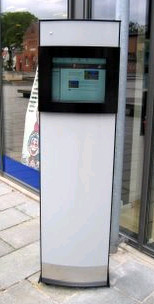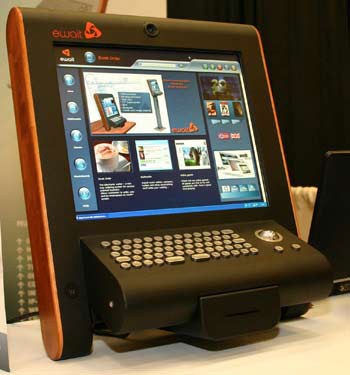Article
Kiosks from the Continent
Looks aren't everything, but they definitely are something. Distinctively European trends in enclosure design are beginning to make an impact in the United States.
March 12, 2006
The days when kiosks are gray boxes described as "It looks like an ATM, but it does something elseÂ…" are waning. European kiosk enclosures are skipping the pond to capitalize on the trend. Two companies, Norway's Ewait and a new division of Euro Touch Kiosks from Tampa, Fla., tout different spins on the same theme: combining function and form.
Both companies' kiosks are stylishly minimalist, eye-catching and refined.
Ewait sells one-piece keyboard/flat-screen combination CT models. They're stand-alone terminals in two varieties: tabletop or mountable. The CT is available in an array of popular contemporary colors with wood or metal side panels. The unit's stylish looks belie its hard-working hardware. From the shiny stainless steel trackball to the waterproof keyboard, the CT is made to withstand high-traffic environments.
Ewait just received its American LLC in Dec. 2005. The company has a California office and is considering another U.S. base. Judging by its reception at February's Self-Service & Kiosk Show, its products will receive an enthusiastic welcome. A throng of attendees three rows deep piled up at their booth to see the black CTs with Birch panels.
"The aesthetic is a typical Scandinavian design," Ewait chief executive officer Kristian Mikkelsen said. "The use and combination of materials like wood, steel and aluminum together, gives it a human friendliness, good functionality and the robustness needed for these products. These materials are used a lot in industry and furniture production in Norway."
Euro Touch wheeled out its elegant workhorses at the same show, just across the aisle from Ewait. Their units were freestanding: rounded metal monoliths with simple touchscreens like something from a Stanley Kubrick film. They've already been deployed heavily across Europe in a variety of applications.
 |
| Euro Touch touts the inviting aesthetic of its outdoor unit, which is also very durable. |
While the outdoor unit looks elegant, its form follows its function. Though only 7 inches thick, it regulates its own internal climate and requires no shelter. It can contain an entire desktop computer for updates and maintenance tasks. Thick steel bars reinforce the slender unit from within, enabling it to resist vandalism. According to Euro Touch Kiosks (USA) president R.J. Kwap, it can almost resist a car crash, though he's quick to point out it does not sport the "16-gage powder-coated steel or injection molded look" of many American kiosks.
"Euro Touch Kiosks blend European good looks and the best quality components," Kwap said. "The anodized aluminum in combination with stainless steel presents an image that draws users to the kiosk. You want to touch these kiosks. Concept Kiosk of Denmark is a provider of ours. They are aesthetic minded, but worked with us to meet all Americans with Disabilities Act accessibility guidelines."
Form following function
American industry watchers saw the Europeans coming. Ron Bowers, senior vice president of business development at Frank Mayer & Associates, supervises the production of some of the highest profile custom kiosks in the domestic market. He said Europeans are very style-conscious and their design techniques consider form and function from the root of the process. He said the popularity of Euro-style kiosks will grow as deployers become more brand-conscious when buying their kiosks - rather than focusing on the bottom line of technical basics.
|
He said the familiar gray plastic and sheet metal look of a typical American kiosk has its roots in the ATM industry, one of the first segments where automated self-service gained widespread popularity a couple decades ago.
 |
| Ewait's tabletop unit on display at The Self-Service & Kiosk Show |
"In the beginning stages, we had a lot of people say, `We don't want (a kiosk) to look like an ATM, we don't want it to have that Darth Vader look,'" Bowers said. "Some of the (ATM) manufacturers of that time worked with metal builders whose expertise was in straight line, heavy duty, tank-type design. They had no idea about marketing or merchandising or form following function."
The shrinking cost of branding
Bowers said advancing production efficiencies, like advances in high-strength plastics, drive down the costs of enclosures. He said custom-made enclosures that used to cost $7,500 to $8,000 each now sell for $800 to $1,500. Meanwhile, thin client technology, flash memory and other factors weigh in to decrease internal component cost and increase potential ROI.
A complete, single Ewait CT (enclosure and inner workings) costs $6,990. The price is negotiable depending on the customer's exact quantity and requirements. Kwap said his units are moderately priced, and final pricing also depends on quantity and specific need.
And while all three companies tout their ability to meet branding needs, Bowers urged caution when considering an enclosure.
"You have to think, `Does it have a look that will date itself?'" Bowers said. "Will it stand the test of time?"











